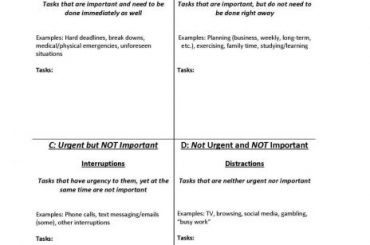Organize, Delegate and Prioritize
Too much to do and too little time. Who hasn’t had the thought come up at some point in their life?
As a business owner, entrepreneur, or service professional, we are handling many moving parts pertaining to working in our business and working on our business.
Just how do we stay on top of things, adhere to deadlines, and handle unforeseen situations?
It is a quick 3 step process:
- Organize: Create a master to do list of all the tasks that you need to accomplish over the next 24 hours.
- Delegate: Delegate all tasks that can be done by another person.
- Prioritize: Prioritize all remaining tasks into one of the four categories below.
- A: Important and Urgent: Tasks that are important and need to be done immediately as well
Examples: Hard deadlines, break downs, medical/physical emergencies, unforeseen situations
- B: Important, but Not Urgent: Tasks that are important, but do not need to be done right away.
Examples: Planning (business, weekly, long-term, etc.), exercising, family time, studying/learning
- C: Urgent, but Not Important: Tasks that have urgency to them, yet at the same time are not important
Examples: Phone calls, text messaging/emails (some), other interruptions
- D: Not Urgent and Not Important: Tasks that are neither urgent nor important
Examples: TV, browsing, social media, gambling, “busy work”
With your list in hand, you can now select which tasks are the most important.
Utilizing this approach to time management will enable you to focus on the things that matter the most.
With a limited amount of time available, you
The Time Management Grid (picture) will make the process easier so that you spend the time you have on the tasks that matter the most.
-













